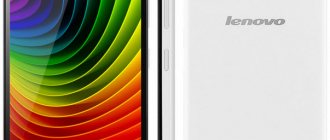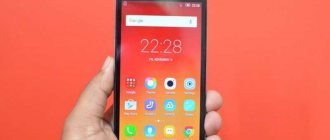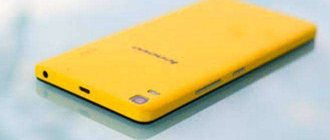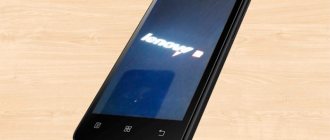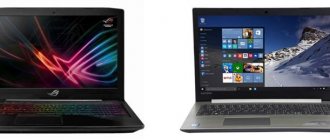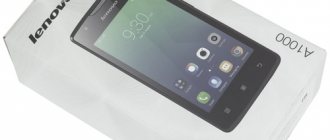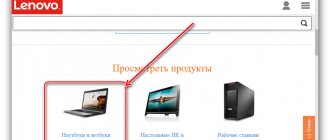Sound
Lenovo Vibe P2 has one multimedia speaker with a power of 1.5 W. The volume of its sound is above average. At the maximum level, no interference is heard: the sound is clear and even surround. There are also no complaints about the conversational speaker - the interlocutor can be heard loudly and clearly. The volume reserve in headphones is also very high: raising its level above 80% is uncomfortable for hearing even in noisy public places. If you use good headphones, the sound quality will be appropriate. The device supports FM radio.
Appearance, controls and connectors
The body of the device has a non-separable design, the back panel and side frames are metal. The front panel is covered with tempered glass, slightly rounded at the edges. Due to the fact that the screen is not covered with 2.5D glass, the smartphone digs into the hand a little. On the body in a golden-cream shade, additional black frames around the screen are clearly visible. In the dark gray version that we reviewed, the additional frames merge with the body.
At the bottom of the screen there is a mechanical button with a built-in fingerprint scanner. To unlock, just one touch is enough - the sensor responds instantly and accurately. In addition, the button can be used to navigate the interface. For those who are accustomed to a more classic control method, it is possible to activate on-screen buttons.
Buttons for volume control and power/lock are on the right side. The opposite side is occupied by a hybrid tray: it can accommodate either 2 nano-SIM or 1 SIM and a MicroSD memory card. Nearby is a mechanical lever for quickly switching the device to extreme energy saving mode.
On the bottom edge there is a micro-USB connector with OTG support, on the sides of which there are symmetrical slots for one microphone and speaker. The top edge is occupied by an additional microphone for noise reduction and a 3.5 mm headphone jack.
Cameras
The main camera is a 13-megapixel Sony IMX258 sensor.
Complemented by fast phase detection autofocus and dual two-color flash. By default, shooting is done in "Smart Mode", which attempts to automatically detect the scene. Based on the data obtained, recommendations are displayed on the display, which are designed to help an inexperienced user get a high-quality shot.
For those who want to get the most out of the camera, the shooting application interface provides a PRO mode. In it you can find manual settings that allow you to adjust shutter speed, exposure, etc. In general, the shooting quality is quite acceptable for a mid-price smartphone.
During the day, in clear sunny weather, you can count on pictures with a good level of detail, contrast and color saturation. Indoors, with a sufficient level of lighting, the result can also be considered satisfactory. But the night shots are not particularly encouraging. With insufficient lighting, there is a sharp decrease in detail and sharpness of frames, and an increase in the amount of digital noise.
Video recording in 4K resolution (30 FPS) is supported. There is a serious lack of optical stabilization when shooting video handheld (as well as in low-light conditions). The 5 MP front camera with fixed focal length is suitable for both selfies and video calling. But it makes no sense to expect serious quality from it.
Autonomy
With active use (social networks, camera, watching videos and even some games), a regular smartphone will be discharged by the evening, or even earlier. Lenovo P2 works quietly in the same mode for 2 days, and under more moderate loads – for all 3 days. The user gets up to 15 hours of active screen time in mixed use mode (if you do not let go of the device).
This is possible thanks to the successful combination of a 5100 mAh battery and the energy-efficient Snapdragon 625 chipset, made using a 14 nm process technology. There are also advanced power consumption settings in the device menu. With their help, you can limit the background activity of individual applications to save battery.
A special lever button on the case that activates the emergency mode will allow the device to operate for 5 days. In this mode, everything is turned off except the telephone part (calls, SMS), as well as basic functions such as alarm clock, calculator and calendar. This takes into account the properties of the AMOLED matrix: the screen is filled with black to achieve even more economical energy consumption.
Thanks to support for Qualcomm QuickCharge 2.0 technology and a powerful included power adapter, the smartphone charges relatively quickly. To fully replenish the charge from 0 to 100% it will take a little over 2 hours.
Display
The manufacturer used a Super AMOLED matrix with a resolution of 1080x1920. The 5.5” display has a decent amount of brightness and boasts wide viewing angles. The picture quality is not inferior to flagships, demonstrating a clear, contrasting image, with rich color rendition and deep blacks. On the street, screen readability remains acceptable.
Those who don’t like the oversaturated gamut typical of AMOLED screens will be able to select a color profile with duller shades in the settings. And the increased sensitivity mode of the sensor will be very useful in the cold season. When activated, the touchscreen responds perfectly to leather gloves.
Design
As we've already noted, the Lenovo P2 hides numerous upgrades on the inside, but you'll be hard-pressed to find anything new on the outside. Design is one area where Lenovo quickly cut time, borrowing everything it could from the P1 without changing much.
Indeed, the P2 has an identical design to the Vibe P1. By the way, we have seen this design reused many times, even in phones from other manufacturers. The smartphone has a metal back with plastic strips on the top and bottom to hide the antennas. The mid-range segment is full of devices using this layout, especially the more affordable lot.
Working with the Lenovo P2 is a breeze - it's a well-built device and quite rugged, so it's well protected. With promising hardware features like these, only unimaginable design will bring it back from being a bestseller.
Software
Out of the box, the smartphone runs Android 6.0.1 OS. A proprietary shell from Lenovo, Vibe UI, is installed on top of the system. Its interface has not undergone many changes compared to the standard Android shell. Added the ability to change themes, an expanded energy-saving mode and some other useful additions. In 2021, an official firmware update to Android 7 is available for this model via an update center (OTA). The first time you turn it on, you can update over the air. Since the Vibe UI shell has minimal changes compared to pure Android, we believe that this is a big plus for the phone (the shell does not eat up RAM, like MIUI from Xiaomi, although there is enough of it in the P2)
Performance
The smartphone uses a mid-range Snapdragon 625 SoC with eight Cortex-A53 cores clocked at 2.0 GHz. But the real advantage of this chip is that it is manufactured using a 14nm FinFET process. The immediate benefits of this manufacturing process are amazing energy efficiency and lower thermal emissions.
So, despite our reservations, the Lenovo P2 seems oriented enough to handle some pressure, and at the same time, it won't get hot, thanks to the power-efficient chipset. It may not be the best future device, but today, it easily gets B-in performance and an excellent energy efficiency and thermal rating.
Volume knob and power/lock key
The top of the Lenovo P2 looks quite busy, but that's an illusion. The main points of interest here are the audio jack and the secondary microphone. At the bottom there is a microUSB port with two grilles, one for the main microphone and the other for the speaker.
Finally, turning the P2 over to examine its rear, we find a 13-megapixel camera lens on the back. It has an aperture of af/2.0 - wider than the Vibe P1 and comes with a dual-tone flash. You may also notice the Lenovo logo and small print that says the P2 was made by Motorola Mobility, which is an interesting lead to this story.
We've always thought that Lenovo owns Motorola and it's more like Moto phones are made by Lenovo rather than the other way around.
